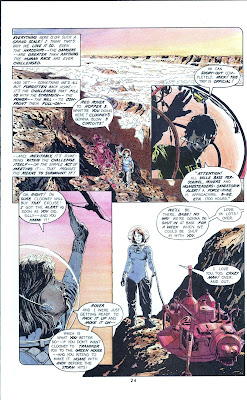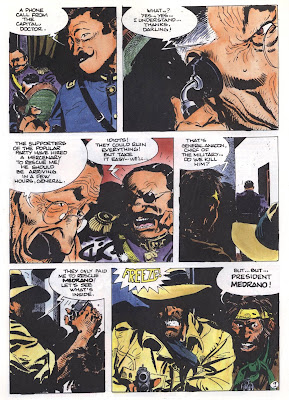edited by Bruce Sterling
4 / 5 stars
I remember reading ‘Mirrorshades’ back in 1988 and thinking it was one of the better sf anthologies I’d ever read. How does it hold up when examined again 30 years later ?
Very well, in fact.
‘Mirrorshades’ contains stories that can be considered ‘First Generation’ cyberpunk. As editor Bruce Sterling states in his Preface, in selecting entries for the book he decided to go with lesser-known stories over more frequently anthologized selections.
All of the entries first were published between 1981 – 1986, many in Omni magazine.
My capsule summaries of the contents:
The Gernsback Continuum, by William Gibson: a photographer finds himself having peculiar hallucinations brought about by documenting crumbling architecture in the Southwest. While it doesn’t adhere very closely to the traditional cyberpunk tropes, 'Gernsback' stands the test of time as an imaginative and effective sci-fi story.
Snake Eyes, by Tom Maddox: a former soldier finds himself tormented by the AI installed in his skull. The author’s tendency to belabor the damaged state of his characters gets tedious as the story unfolds, and 'Snake Eyes' suffers as a result.
Rock On, by Pat Cadigan: Even when down and out, a singer refuses to compromise her dedication to Rock music..........and by extension, Art.
I’ve always considered Cadigan to be one of the more underwhelming authors designated as a 'cyberpunk author', and this brief tale doesn’t do much to change my mind.......the fact of the matter is that John Shirley (below) is superior at doing the whole 'rock-and-roll angst' trope.
Tales of Houdini by Rudy Rucker: the legendary escape artist decides to take on some uniquely hazardous challenges.
This story is one of the best in the anthology, and one of the best to emerge from the genre’s First Generation. On the surface it’s the type of fantasy tale that the New Wave authors of the 70s tried time and time again to perfect (usually without success). It’s telling that Rucker not only does what they wanted to do, but completely surpasses them within the limitations of a story that is only six pages long............!
400 Boys, by Marc Laidlaw: Inner-city gang-bangers confront an otherworldly threat. Another of the better entries in the anthology. ‘400’ is just as surreal as Rucker’s story, but at the same time, its prose style stays grounded, and (unlike so many New Wave tales) this one has a coherent plot.
Solstice, by James Patrick Kelly: a designer drug guru and his Close Companion struggle to achieve a Meaningful Relationship. There are some interesting ideas in this story, but unfortunately it gradually collapses under the weight of trying to say Something Insightful about the Human Condition.
Petra, by Greg Bear: another surrealistic entry, this time about medieval demons and devils brought to life in the aftermath of The Singularity. I didn’t find it as effective as the entries by Rucker and Laidlaw.
Till Human Voices Wake Us, by Lewis Shiner: a company man on vacation in Belize makes a startling discovery. A competent, if not particularly remarkable, tale.
Freezone, by John Shirley: this novelette is actually an excerpt from Shirley’s novel Eclipse, the first volume in the so-called A Song of Youth trilogy.
Given that the stories immediately preceding it are not ‘traditional’ cyberpunk, the placement of ‘Freezone’ at this position in the anthology is crucial in reminding the reader what the core tropes of the genre are all about. Rockers, druggies, smugglers, corporate assassins, and deviants all mix and mingle in the eponymous city-state erected on a gigantic raft in the Atlantic. ‘Freezone’ remains quintessential, undiluted, 100-proof Cyberpunk and that’s a good thing.
Stone Lives, by Paul Di Filippo: another traditional cyberpunk tale, and another of the better entries in the anthology: a man is transported from the mean streets of a decayed New York City to more wealthy environs, where he discovers he’s been assigned an unusual mission by a mysterious patron.
Red Star, Winter Orbit, by William Gibson and Bruce Sterling: Cosmonauts confront the scheduled end of their terms on an obsolescent Russian space station. This story just doesn’t do all that much for me.
Mozart in Mirrorshades, by Bruce Sterling and Lewis Shiner: what happens when we can time travel to 18th century Salzburg, and there’s no such thing as a Prime Directive ? This is one of those rare times when a collaboration brings out the best in each author. ‘Mozart’ is not only one of the best tales in the anthology, but one of the best cyberpunk stories ever written.
The verdict ? While it has its share of less impressive entries, ‘Mirrorshades’ still can lay claim to being not just the best cyberpunk anthology ever published, but one of the best sci-fi anthologies ever published.
Having read more sci-fi anthologies than I like to think
about, with most of them originating in the 60s and 70s, I can confidently say
that ‘Mirrorshades’ beats any volume from any of them: Orbit,
Best Science Fiction Stories of the Year,
Year’s Best SF, New Dimensions, Nebula Award Stories,
Dangerous Visions, Quark, Universe, Stellar, etc. etc.
Unfortunately, both the hardcover and the paperback versions of 'Mirrorshades' are long out of print and those copies that are listed for sale at the usual online outlets are exorbitantly priced (namely, $25 and up for a paperback in good condition). All I can recommend is to keep an eye out for a reasonably priced copy at any used bookstore you happen to patronize ( in April, I picked up a copy in Very Good condition for $3.50 from Hole in the Wall Books in Falls Church, Virginia).

















































.jpg)























